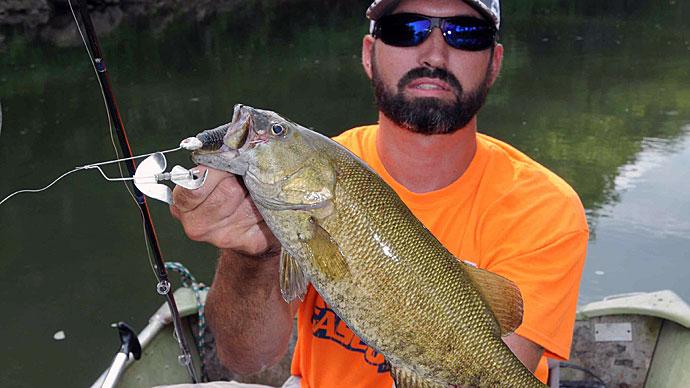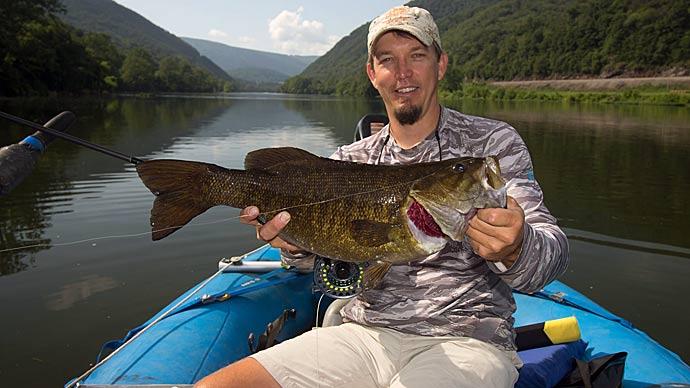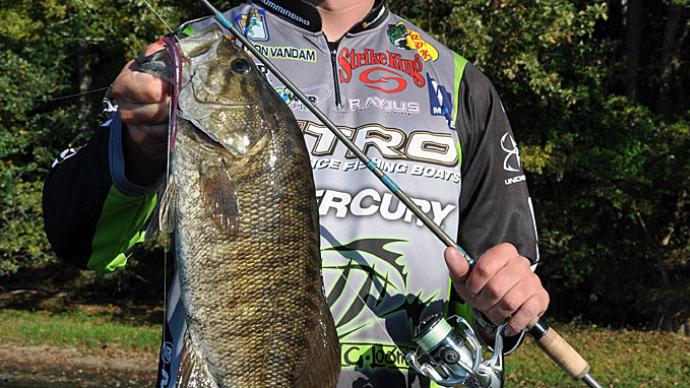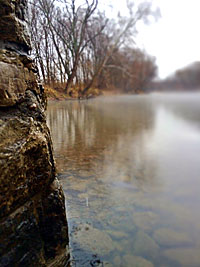
When you think of typical smallmouth fishing hotspots, you're sure to focus on places such as the Great Lakes in the northeast United States or an extensive river system in your locality known to produce smallmouth. However, an often overlooked option for landing quality bronzebacks might be in your local small river.
Small rivers accommodate many aquatic animals, ranging from microscopic phytoplankton to larger frogs, crayfish, and other fish. These abundant food sources present an opportunity for thriving and active numbers of smallmouth. The biggest challenge is deciphering these hard-fighting fish when the river rarely gets deeper than the knees. As bass anglers, we're not usually accustomed to fishing in such shallow rivers, but let's break down some points that might help you experience a great day wading a river.
Before we start, I want to point out the critical necessity of safety. We often hear of anglers drowning in what would seem to be shallow or insignificant conditions. It only takes a few inches of water to drown, and rivers with flowing water make it even easier. A few close encounters have seen me purchase a fishing vest-lifejacket-type hybrid. They're much less bulky than a standard life jacket. Since the inevitable slip into the water will be in your future at some point, you don't have to worry as much about an automatically inflating PFD. No matter what you choose, please ensure you wear some personal floatation method.
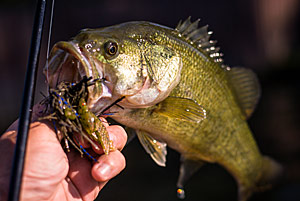
Keep a sharp eye out for bottom contour changes and large rocks, as these will cause slips and trip-ups. A good pair of polarized sunglasses will allow you to see into the water and wade safer. Lastly, get a good pair of gloves, even half-finger gloves. Rivers tend to have an abundance of sharp rocks, broken glass, or rusty aluminum debris on the bottom. If you have a good pair of gloves, you can save yourself a ruined fishing trip and subsequent trip to the emergency room. Take a look at cycling or weightlifting gloves since they tend to be form-fitted, breathable, and half-finger for effective casting.
The first tip is pretty evident: you'll likely want to get a good pair of waders. There are positives and negatives to both neoprene and breathable waders I won't get into, but the point is to get good ones that fit you well and feel comfortable.
Additionally, having an excellent wading vest is helpful. The vests allow you to carry tackle in smaller packs, allowing for better water mobility. Be sure also to consider good sun protection, including an excellent hat to cover your face and neck, sunscreen, or a long-sleeved SPF-rated fishing shirt. Also, keep in mind changes in the weather. Be sure you can slip off a sweatshirt if you get too warm or put on a hat if it gets cold.
Keep an eye on your weather forecast and be prepared. More than once, I've hit a nice patch of river with good fishing, only to see it ruined by not having the proper clothing and having to head back to the car. Now that you're outfitted, let's cover technique, presentation, and practical advice.
First, remember that small rivers and streams are notorious for being crystal clear. Fishing clear water is a challenge, and here is where we should use a great lesson from our fly fishing friends in being stealthy. Approach the water with ease and take great care not to make a disturbance. Wear colors that blend your profile in with what fish see when looking up. Think trees or blue skies.
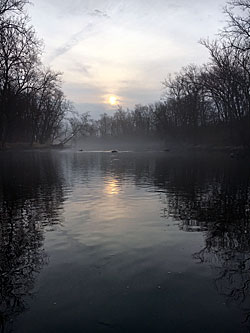
Additionally, try to ease through the water. Take measures to ensure you're not making large splashes and commotion in the water. Any disturbance will alert and spook the fish. Use rod and reel combinations that cast long distances. The farther you cast the lure, the more your odds of hooking a fish will increase. Also, ensure the profiles of the lures you use to match your stealthy nature. It does not do much good hurling giant baits that make the sound of a depth charge going off every time one hits the water. Lures with small profiles are unobtrusive and quiet.
Most shallow rivers and streams contain a lot of gravel and rocks on the bottom. Shallow water typically moves fast, which does not give moss, algae, and debris a chance to form, so you're usually left with rocky bottoms. For this reason, I almost always use fluorocarbon line or a leader if I'm using braid. Rocks, gravel, and shellbeds will slice braid easily and a good fluorocarbon will likely save the day. As always, be sure to inspect your line a bit more often than usual for frays and nicks.
Next, develop your ability to discern the bite of the fish. With so many rocks, laydowns, and river debris present, your lure will bump into scores of objects. Learn to feel the difference between these objects and the tick of fish biting. They're subtle in some cases and violent in others. An excellent lesson to perform is to stand in an elevated position and pull your lure through the water in a manner that makes it visible. Bump it into rocks and sticks, drag it on the bottom, then memorize how it feels. Keep doing this, and you'll learn the difference between hitting a small rock and getting bit by a nice fish. Often, a smallmouth will only briefly swipe at a lure, so you must quickly and effectively discern a bite.
Lastly, it's imperative that you take a good look at the surrounding structure and fish smart. Smallmouth in shallow water are notoriously finicky and will more strictly relate to the structure and bottom composition changes than smallmouth found in lakes. In extreme cases, I've seen them crowd up on the only shadow in the river for a hundred feet. In a nutshell, it amplifies all of the fish behavioral tendencies of our normal largemouth and smallmouth fishing knowledge. There, you'll have the tendencies of shallow water smallmouth.
Beautiful and enjoyable days can be had in shallow rivers and streams. These bodies of water can produce excellent fishing if you take the proper measures. Take a friend along and make some beautiful memories. Be sure to hang on; those little bronze fish sure can fight.
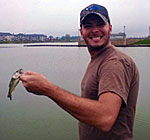
Phillip likes to fish in whatever water is wet and usually likes to catch anything with fins, scales, and eyes, but he prefers bass. His greatest joy of fishing is teaching a child to fish. He strictly practices catch-and-release but sometimes doesn't have to worry about that after a particularly weak hookset.


